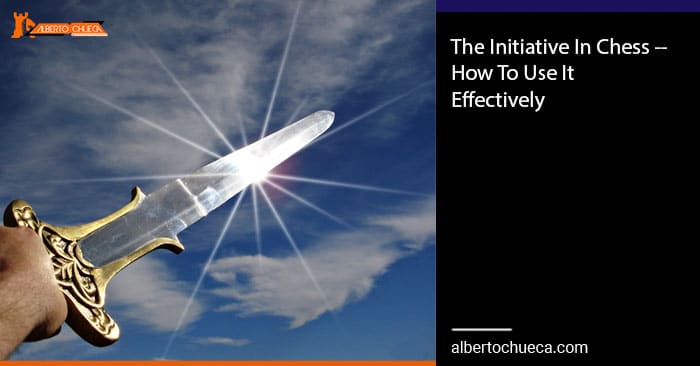Table of Contents
The Initiative in chess
The Initiative in chess sounds like one of those terms only Grandmasters use for commentary. Is this a concept that beginner and intermediate players can pick up as well? Absolutely!
What is this concept that many players struggle to understand? The initiative in chess is the act of creating consecutive threats at your opponent, forcing them to respond. The advantage of having the initiative in your chess games is that when your opponent reacts to your threats, he has no time to formulate a plan of his own, which can give you an overwhelming advantage.
Again, this may sound like an advanced concept only GMs use, though a few examples will show that anyone of any skill can utilize the initiative for their own games. Let's see a few examples:
The Greek Gift Sacrifice – Chess Initiative Example
I'm positive many of you have heard of this sacrifice. The Greek Gift is a profound example of how the initiative can be executed in your favor. Many of you are aware of this concept, though let's show an example for illustrative purposes:
In the position above, White is already well-poised for Kingside play, with the Queen, Bishop, and Knight all having a potential influence on that side of the board. As a result, White is able to throw 1. Bxh7+! in Black's camp. The Bishop immediately creates a threat — against the King himself!
Black already has an unpleasant position, whether he accepts the sacrifice or not. Therefore, Black obliges, 1… Kxh7. Here comes 2. Qh5+. White will not let Black rest! After the King steps back to g8, we see White's initiative start to come to fruition.
3. Ng5 comes, and the mate threat on h7 is too much for Black to deal with. Black is obliged to give up his Queen or allow a mate in five after 3… Re8. For example, after 3… Re8, White plays 4. Qxf7+, Kh8 5. Qh5+, Kg8 6. Qh7+, Kf8 7. Qh8+, Ke7 8. Qxg7#.
A fitting way to finish a game dominated by white via the initiative during this chess game.

The Opera Game
Many of you are probably also aware of the famous Opera Game played between the great Paul Morphy, and a team of allies at an opera show. This game is primarily remembered for the speculative sacrifices, and the aesthetic checkmate, though this game also serves a good example of pounding the initiative at your opponent.

Black just played 9… b5 in the diagram above. Paul Morphy does not sit back and retreat, rather he lashes out 10. Nxb5! After 10… axb5 11. Bxb5+, this is only the start of an overwhelming initiative for the White player. After Black blocks the check, White fuels the fire with 12. O-O-O!
Black is not left off the hook! White's Bishop and Rook formulate an attack on the Knight on d7, due to the f6-Knight being pinned. Black defends the Knight with 12… Rd8, though due to the pressure, lead in development, and initiative by White, he is able to throw 13. Rxd7, Rxd7 14. Rd8!
As a result of White's aggressive play, Black is on his heels the whole game. Black tried defending with 14… Qe6, though that simply didn't bode well after 15. Bxd7+, Nxd7 16. Qb8+!!, Nxb8 17. Rd8#. See what good the initiative in chess can do for your games?
Possessing the initiative in chess out of the opening
Most people this day in age tend to play more positionally and conservatively. However, there are still openings out there, especially those “romantic era” openings which are designed to fuel an early initiative. The Danish Gambit is a good example. Modern-day computers have borderline refuted romantic gambits such as this, the King's Gambit, etc, though the games of the 1800s and 1900s are still a joy to watch. The Danish Gambit comes after 1. e4, e5 2. d4, exd4 3. c3, dxc3 4. Bc4, cxb2 5. Bxb2.
Yes, White is down two pawns, though look at those monster Bishops! As Paul Morphy showed us, material may not matter as long as you have the initiative.
This game we're following, White won in 11 moves, though let's not throw too much criticism to the player's, as this game was played in 1922, years before chess computers came out!
Black proceeds with 5… Bb4+. White responds normally with 6. Nc3. The game starts to get fishy after Black's 6… Qg5?!. I guess his intention was to go after the g2-pawn. However, after White's 7. Nf3!, attacking the Queen, the pawn is simply untouchable. If 7… Qxg2, 8. Rg1 and the Black Queen will be held hostage on that side of the board forever.
A few moves passed. 7… Qc5 8. Qb3 (attacking the f7-pawn), Nh6. After both sides castle, the initiative starts to get real for White.
White orchestrates a winning attack with 10. Nd5! White's pressure it too overwhelming. After Black moved the Bishop to a5, 11. Ba3 ensued, and Black resigned the game.
Having the initiative does not have to be flashy sacrifices
Good news for positional players who are not natural attackers and sacrifice players! The initiative in chess can be picked up by simple, though effective moves without having to be flashy. Take, for example, this game played between former world champion Viswanathan Anand, and Armenian super-GM Levon Aronian played in 2009:
Anand is White, Aronian is Black. The position does not seem to be anything very unusual. That is until Black unleashes 13… Qg5!, and suddenly, White is left with an uncomfortable decision to make if he does not want to lose the g2-pawn. He can castle, though 14… Bh3 (the g2-pawn is pinned), would be killer. Kf1 is also possible, though who wants to move their King without castling? Anand elected to play 14. g3, which severely weakens the light squares around the Kingside.
Black proceeded with a quiet move, 14… Qf6. After 15. Bb2, Qf3, we clearly see the effectiveness as a result of Aronian's play early on.
We clearly see the devastating effect the Queen has on the enemy territory. Black went on to win in ten more moves.
The Initiative in summary:
To summarize what the Initiative in chess is, the initiative is when one side gets to “call the shots”, or force the opponents to react to your threats. It's a big advantage in your chess games because you are barely playing a game of chess if all you do is react to your opponent's threats and commands! Try this out in your own games. You may have to step outside of your comfort zone, possibly sacrifice material, and yes, your opponents may defend well, and beat you. However, you will be glad you knew this skill when the critical moments come. And it will not disappoint.






